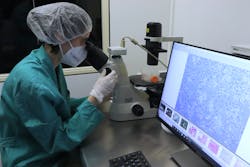Changing the face of cancer treatment with light-controlled drugs
Controlling the biological activity of medications could prompt very specific and highly effective therapies and treatment of cancer and potentially other diseases. Researchers at the Institute for Advanced Chemistry of Catalonia (IQAC), under the Spanish National Research Council (CSIC), have found a way via photopharmacology (see video).
The emerging approach is essentially drugs (photosensitive molecules) controlled by light; it also regulates the drugs’ biological activity.
“We use light as an external factor to control the activity of small molecule drugs,” says Laia Josa Culleré, research lead and a postdoctoral researcher in IQAC’s Medicinal Chemistry and Synthesis group. “In an ideal scenario, drugs are completely inactive in the dark. Under illumination, the drugs change their tridimensional structure, which changes their binding to the biological target, and they are active.”
The team’s work includes a caged design, in which a known drug is modified to incorporate a functional group that renders it inactive. The active drug is released upon illumination in an irreversible process. They also developed a photoswitching design, in which a known drug is modified to incorporate a functional group that changes configuration upon illumination in a reversible manner. In this second design, the biological activity of the drugs can be switched both on and off.
Unlike optogenetics, the IQAC team used standard small molecules, and do not need to engineer cellular components or therapeutic targets. “This external control with light should enable us to use higher doses, prompting higher efficacies, avoid effects in other healthy tissues to lower side effects for patients, and adjust the dose and regimen to each patient, essentially personalized medicine,” Josa Culleré says (see Fig. 1).
The light-regulated drugs have been used in vitro and in vivo to control biological activity with external light in some therapeutic areas. For example, she says her team demonstrated the use in vivo in a mouse model of pain.
The research focused on cancer treatment, which can be challenging with conventional techniques. The efficacy of cancer medications is often limited, as they cannot always differentiate between diseased and healthy cells and can cause negative side effects. Josa Culleré says another big limitation of current drugs is that their biological activity cannot currently be controlled in space and time.
The team is working on a well-known target in oncology—the enzyme histone deacetylase. Its known inhibitors are highly toxic, which limits their progression to patients. “For this reason, we thought they would be a really good example,” Josa Culleré says. “By making them light-responsive, we could avoid toxic effects in other tissues.”
Beginning with the known inhibitors, the structures were modified to introduce a light-responsive functional group. Developing a library of molecules (essentially the drugs) with different structures allowed the researchers to evaluate the biological and photochemical properties. In the first series of molecules, the team saw differences in activity between dark and light conditions at more than 50-fold in the enzyme assays. In cellular assays with cancer cell lines, they found that some of those molecules reduced cancer cell growth when previously illuminated, but not in the dark.
“This is the first important difference with other reported molecules—a robust difference in cellular assays,” Josa Culleré says. One limitation discovered with the first series of molecules: they could only be activated using UV light, which isa problem because such light can be harmful to tissues and has low penetration.
The team addressed the challenge by creating new molecules that can be activated under green light, in the visible range. “This is an important novelty of our molecules,” Josa Culleré says. “Most of the other reported ones require UV or low-wavelength blue light.”
The long-term goal is to present their molecules (drugs) in the clinic to treat cancer patients in a more efficacious and safer manner with fewer side effects. “The next step will be to progress the molecules to in vivo studies,” Josa Culleré says. “For this, we will first have to optimize the molecules and then the idea will be to establish a cancer model in mice where we will generate a subcutaneous tumor.”
Such tumors are rather superficial, and because these molecules can be activated under visible light, it will allow the researchers to illuminate from the top of the skin to activate the molecules only in the tumor area, not in the rest of the body. They can then compare the effect of their molecules under dark vs. illuminated conditions, as well as vs. standard chemotherapy.
“We expect that our molecules will provide a reduction of the tumor only under illumination, which will be larger compared to standard treatment, and with fewer toxic effects,” Josa Culleré says. Beyond that, the molecules’ activity, physicochemical properties, pharmacokinetic profiles, and photochemical properties will need to be optimized. This could aid in the development of devices that can deliver light in vivo, and ultimately lead to clinical approval for the molecules (drugs) to replace conventional chemotherapy treatments (see Fig. 2).“These drugs will combine the spatial precision of radiotherapy with the molecular precision of radiotherapy, giving a more efficacious treatment for the patients with fewer side effects,” Josa Culleré says, adding that her team’s method could potentially be used beyond oncology. “Our group already has ongoing photopharmacology projects for cardiology, vision, and neurological conditions.”

Justine Murphy | Multimedia Director, Digital Infrastructure
Justine Murphy is the multimedia director for Endeavor Business Media's Digital Infrastructure Group. She is a multiple award-winning writer and editor with more 20 years of experience in newspaper publishing as well as public relations, marketing, and communications. For nearly 10 years, she has covered all facets of the optics and photonics industry as an editor, writer, web news anchor, and podcast host for an internationally reaching magazine publishing company. Her work has earned accolades from the New England Press Association as well as the SIIA/Jesse H. Neal Awards. She received a B.A. from the Massachusetts College of Liberal Arts.

